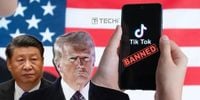In a move that’s sent shockwaves through the global tech and diplomatic communities, the United States and China have reached a tentative agreement to transfer TikTok’s American operations to a US-based entity, potentially averting a ban on the wildly popular short-video app and signaling a rare moment of compromise amid persistent trade tensions between the world’s two largest economies.
The breakthrough, announced by US officials including Trade Representative Jamieson Greer and Treasury Secretary Scott Bessent, follows months of intense negotiation and mounting pressure. According to RADII, the deal was hammered out after talks with Chinese counterparts, with the critical framework and financial terms now settled, though the finer commercial details remain closely guarded. The agreement aims to address long-standing concerns in Washington about data privacy and the influence of Chinese ownership on American users’ information.
The final touches to the deal are expected to be applied during a high-profile meeting between President Donald Trump and President Xi Jinping, scheduled for September 19. The symbolism of both leaders stepping in to finalize the arrangement underscores TikTok’s status as more than just a social media platform—it’s become a flashpoint in broader US-China relations, touching on issues of national security, economic leverage, and digital sovereignty.
For ByteDance, TikTok’s Beijing-based parent company, the move is a calculated effort to alleviate the national security concerns that have dogged its US operations for years. As Reuters reported, TikTok has faced the very real threat of being banned in America unless it shifted to US ownership—a risk that’s loomed for over a year. The new framework provides a lifeline, allowing TikTok to continue operating in its largest Western market, where it boasts more than 170 million users.
But what exactly does the deal entail? While the commercial specifics have not been made public, Reuters and South China Morning Post both note that the arrangement features a US-dominated board, giving American stakeholders enhanced influence over the app’s operations. Treasury Secretary Scott Bessent emphasized that the structure respects US security interests without completely sidelining Chinese stakeholders, a balancing act that aims to preserve some measure of goodwill between the two nations. "The arrangement respects US security interests without sidelining Chinese stakeholders," Bessent assured, according to agency reports.
The agreement is not yet set in stone. The current framework serves as a foundation, with the transaction slated to be finalized by December 16, 2025. This window allows for further negotiation and possible adjustments—a recognition, perhaps, of the complex political and commercial interests at play. US Trade Representative Jamieson Greer indicated that a temporary extension could be granted to ensure the deal’s completion, remarking that “there would have been no extension, indeed, without some sort of structure.”
The negotiations themselves, which took place in Madrid on September 14 and 15, were about far more than just TikTok. As Reuters highlighted, the talks touched on a range of thorny issues, linking the fate of TikTok to ongoing disputes over tariffs, technology transfer restrictions, and even broader topics like money laundering and the illicit fentanyl trade. The US and China, despite their differences, found common ground on some of these fronts, opening the door to potential cooperation beyond the digital sphere.
From Beijing’s perspective, the deal is both a concession and a strategic play. By agreeing to a framework that allows for US oversight, China avoids the immediate humiliation of seeing one of its most successful international tech exports banned from a critical market. At the same time, Chinese negotiators have insisted on retaining the right to review and approve matters related to technology exports, intellectual property rights, and licensing agreements involving TikTok—a point underscored by analysts cited in the South China Morning Post.
“The Chinese side maintains the right to review technology exports, intellectual property rights, and licensing agreements related to TikTok,” noted one analyst, highlighting the delicate balance of interests at stake. The deal may ultimately involve a new ownership scheme or allow US licensing of proprietary technologies, but those specifics are expected to be unveiled only after the anticipated Trump-Xi call on September 19.
The stakes, both economic and political, are enormous. TikTok is not merely a platform for viral dances and memes; it’s an economic engine for countless American creators, small businesses, and influencers, and a key avenue for political messaging—especially among younger voters. A ban, as some in Washington have threatened, would have provoked significant backlash from users and businesses alike. Yet, letting TikTok continue under Chinese control was seen by many lawmakers as a security risk too great to ignore.
For Washington, the framework agreement is a way to assert greater control over the app’s data and operations, addressing mounting concerns about foreign influence and digital espionage. For Beijing, it’s a way to protect its business interests and keep vital trade channels open, even as it pushes back against what it sees as unfair targeting of Chinese technology firms. The deal, then, is as much about saving face as it is about setting precedent for future tech and trade disputes.
Yet, as both sides acknowledge, the truce is fragile. The framework is just that—a structure, not a definitive agreement. Many questions remain unanswered: Will TikTok be fully sold to an American company, or will it operate under a new governance model that satisfies both governments? How will technology licensing and intellectual property be managed going forward? The answers to these questions will determine whether the deal becomes a model for cooperation or another chapter in the ongoing saga of US-China rivalry.
With the US election cycle heating up, political pressure is mounting on both sides. President Trump, who has long advocated a tough stance on TikTok, is keen to showcase the agreement as a victory for American security and economic interests. The Biden administration, meanwhile, is positioning itself as firm but pragmatic, seeking to balance national security with economic stability. For China, the priority remains protecting its global tech champions while avoiding escalation that could further destabilize trade relations.
As the world waits for the details to emerge following the Trump-Xi meeting, one thing is clear: the fate of TikTok has become a bellwether for the broader contest between Washington and Beijing over technology, security, and global influence. The coming weeks will reveal whether this tentative accord is a fleeting pause or the first step toward a more stable digital future.


